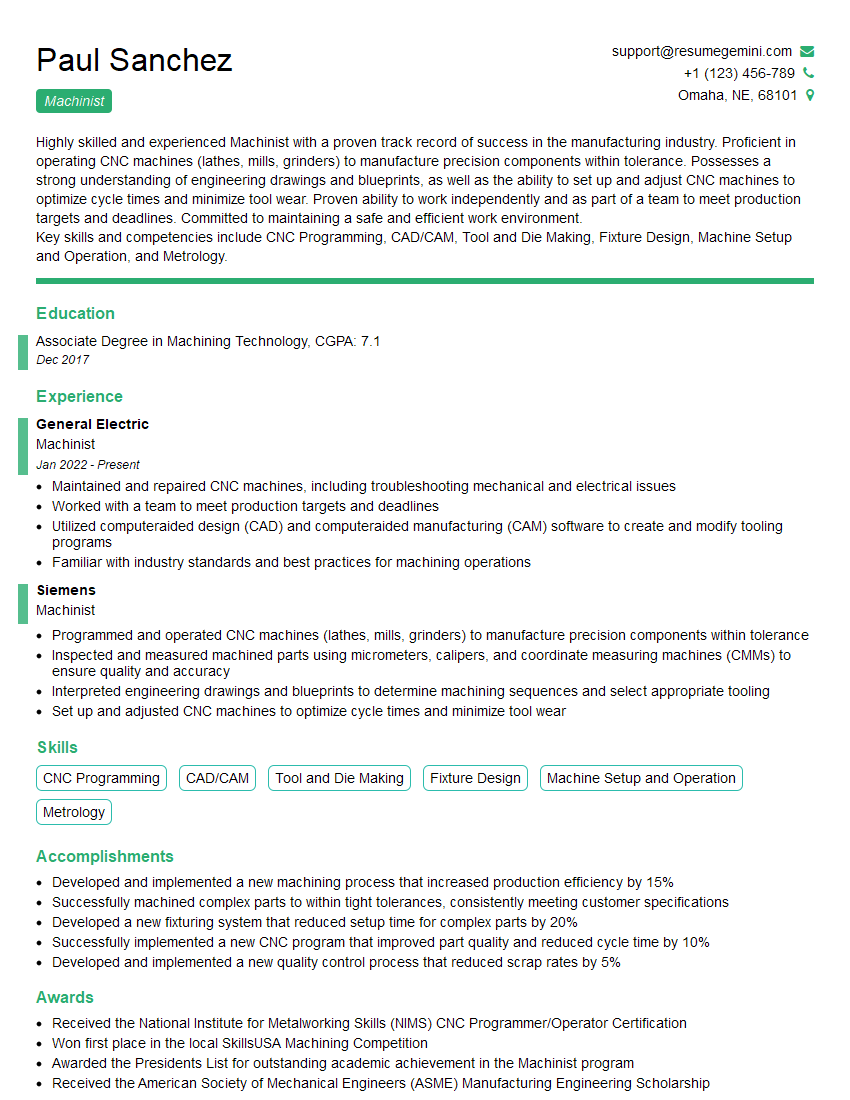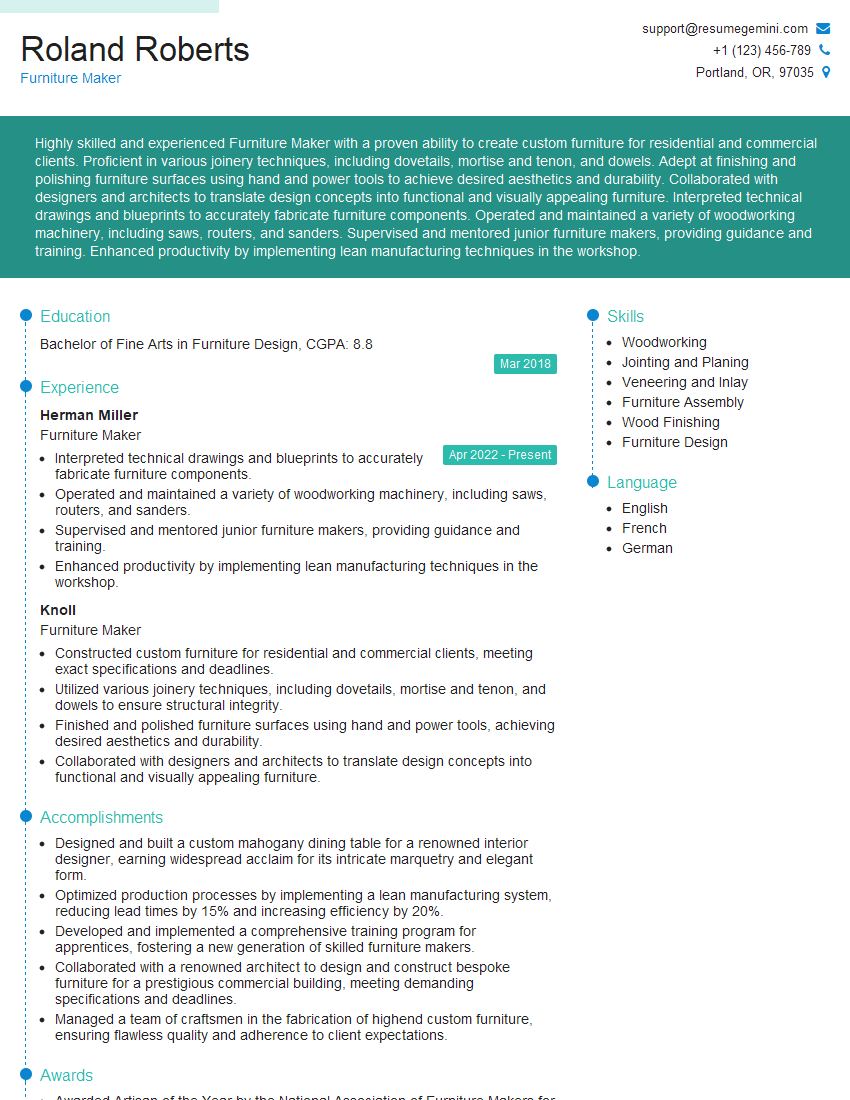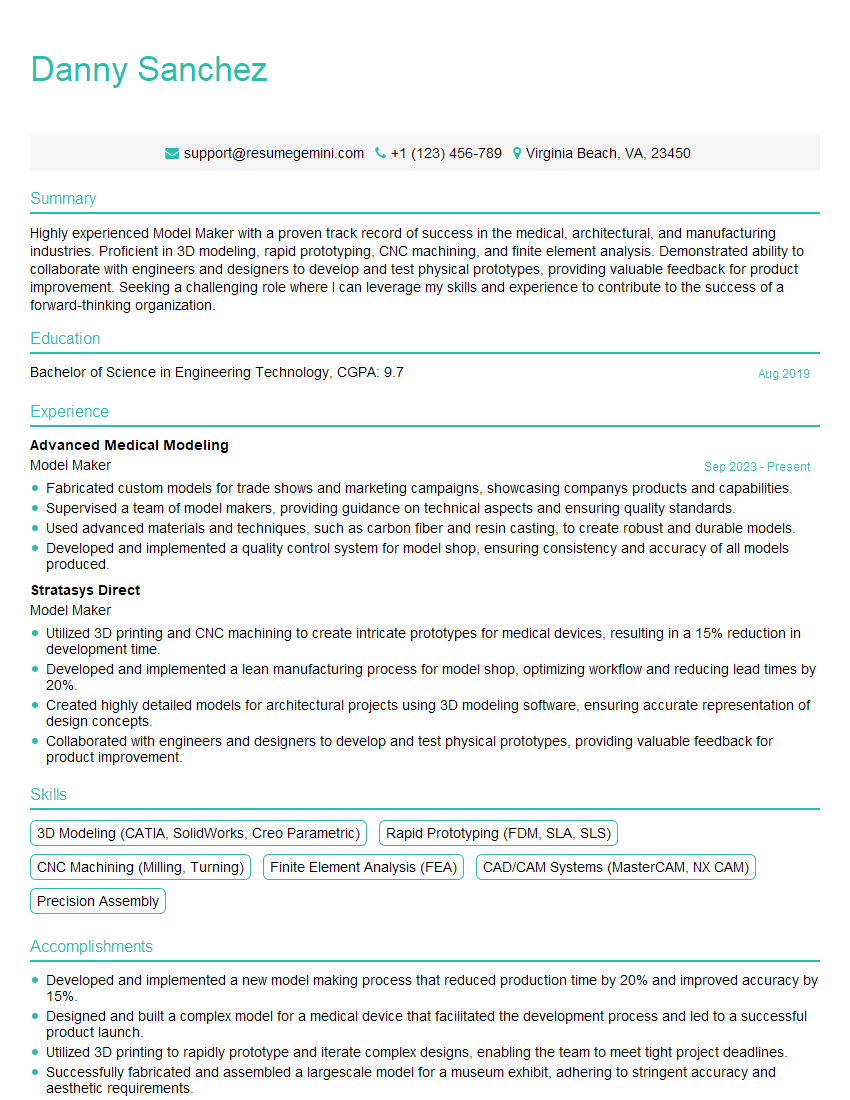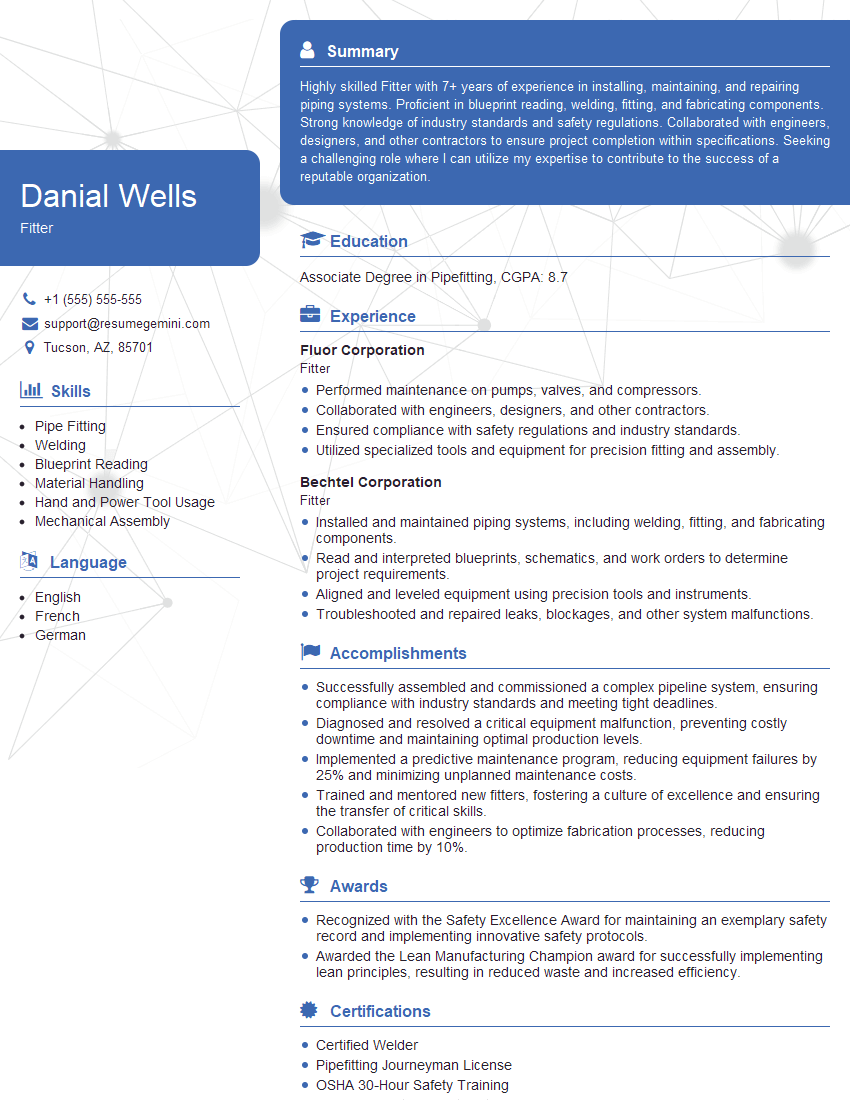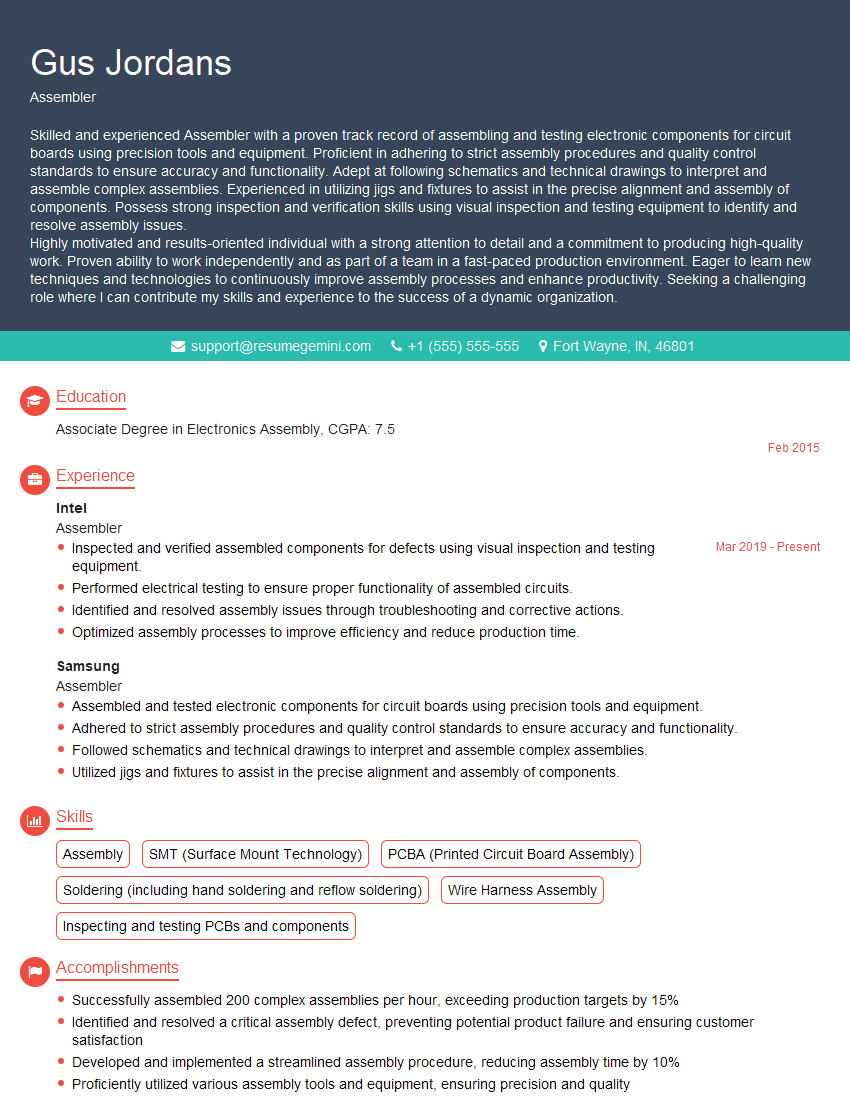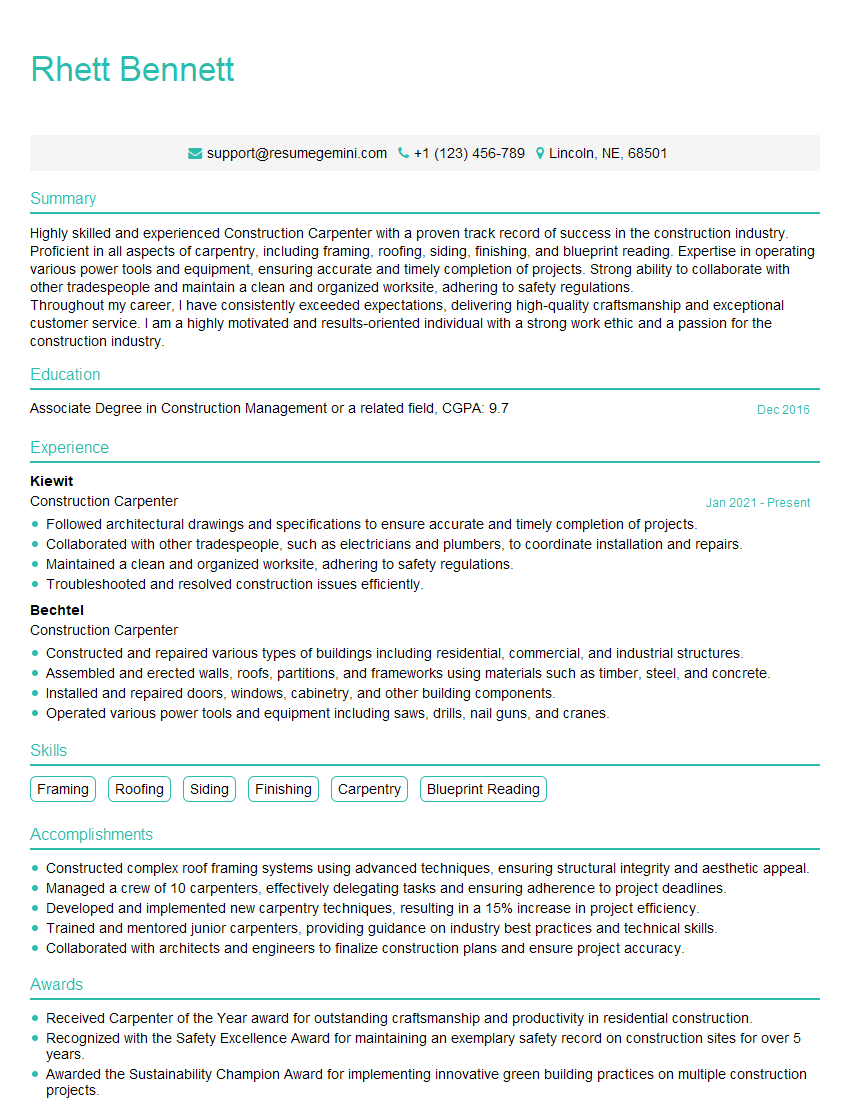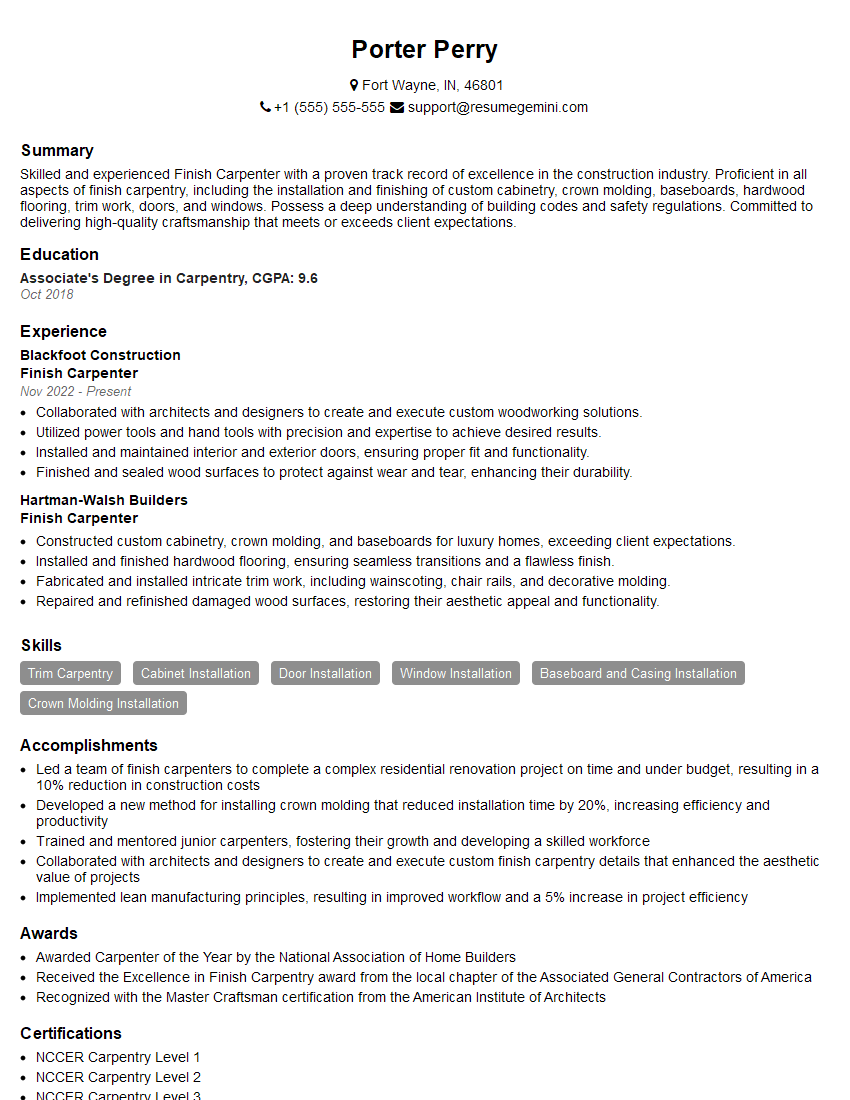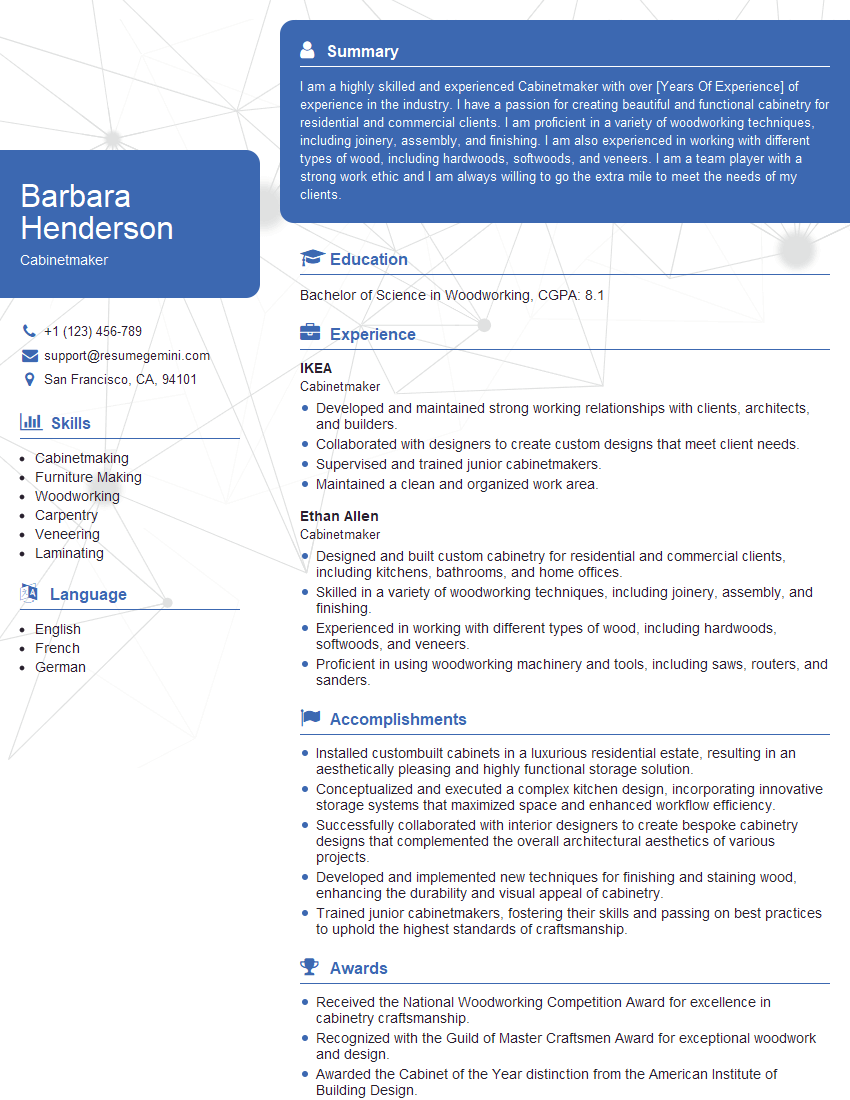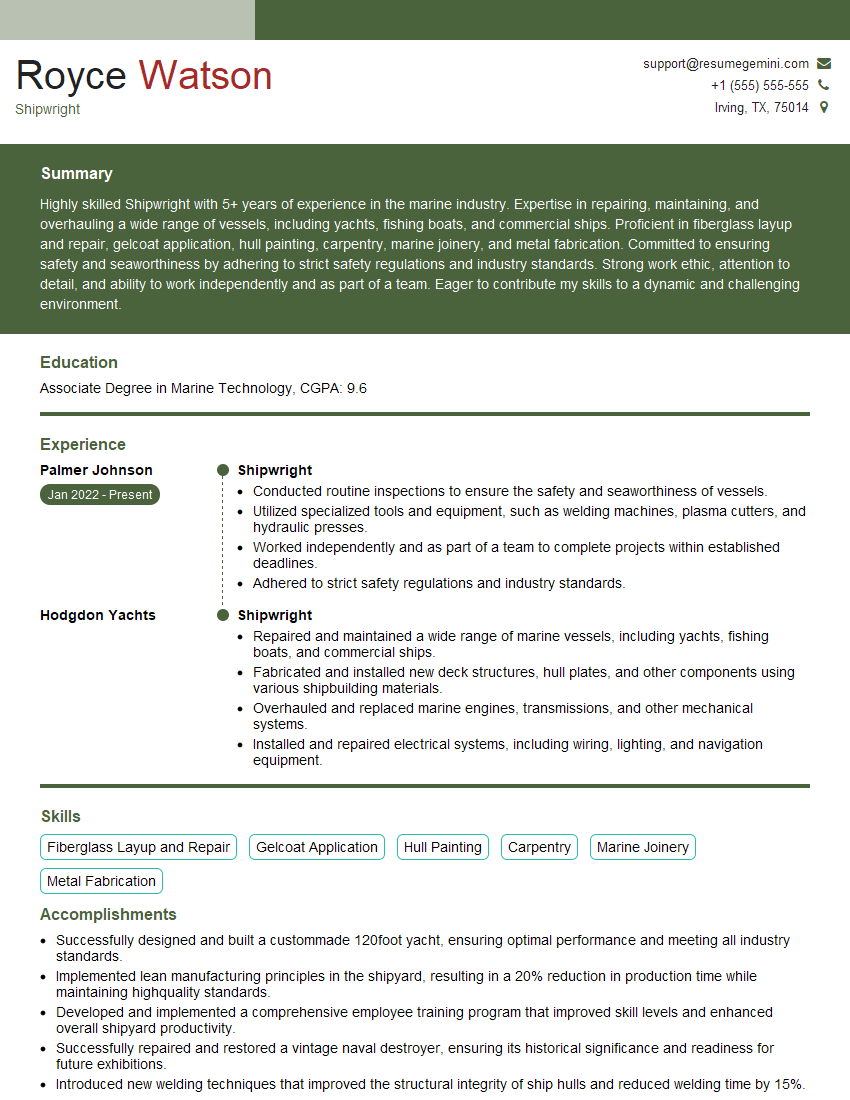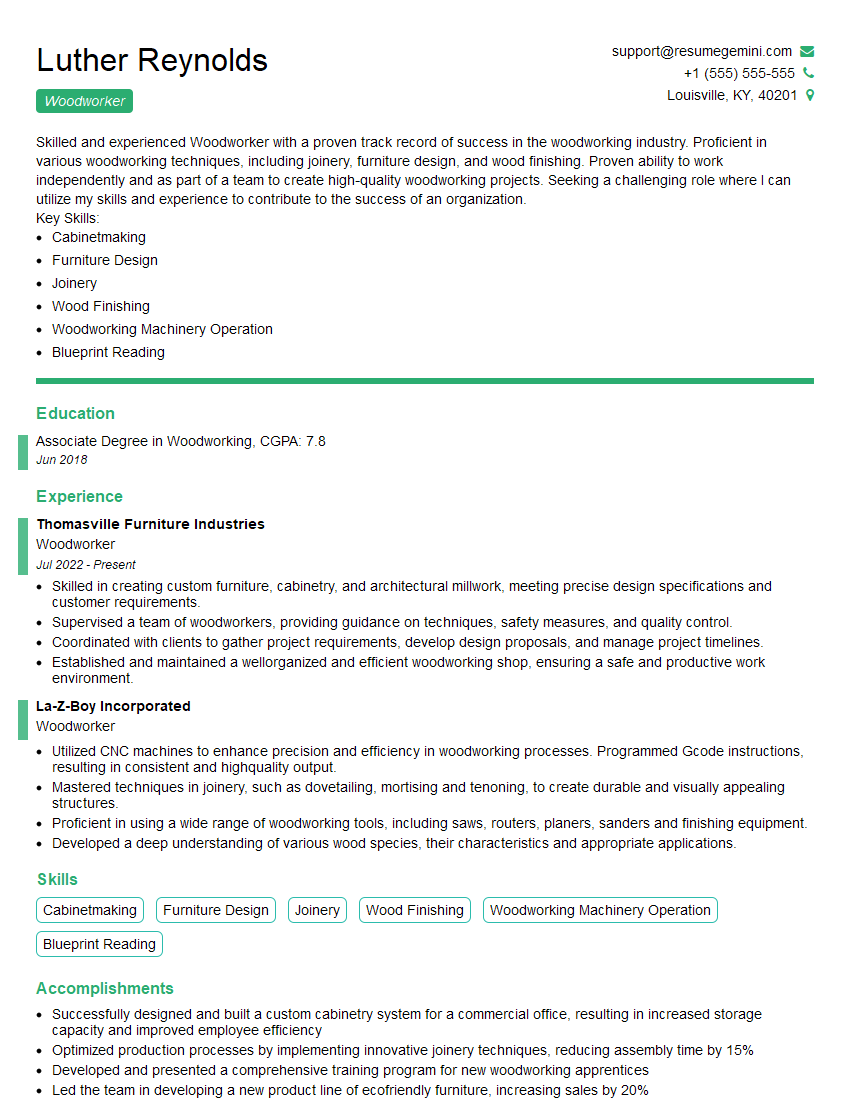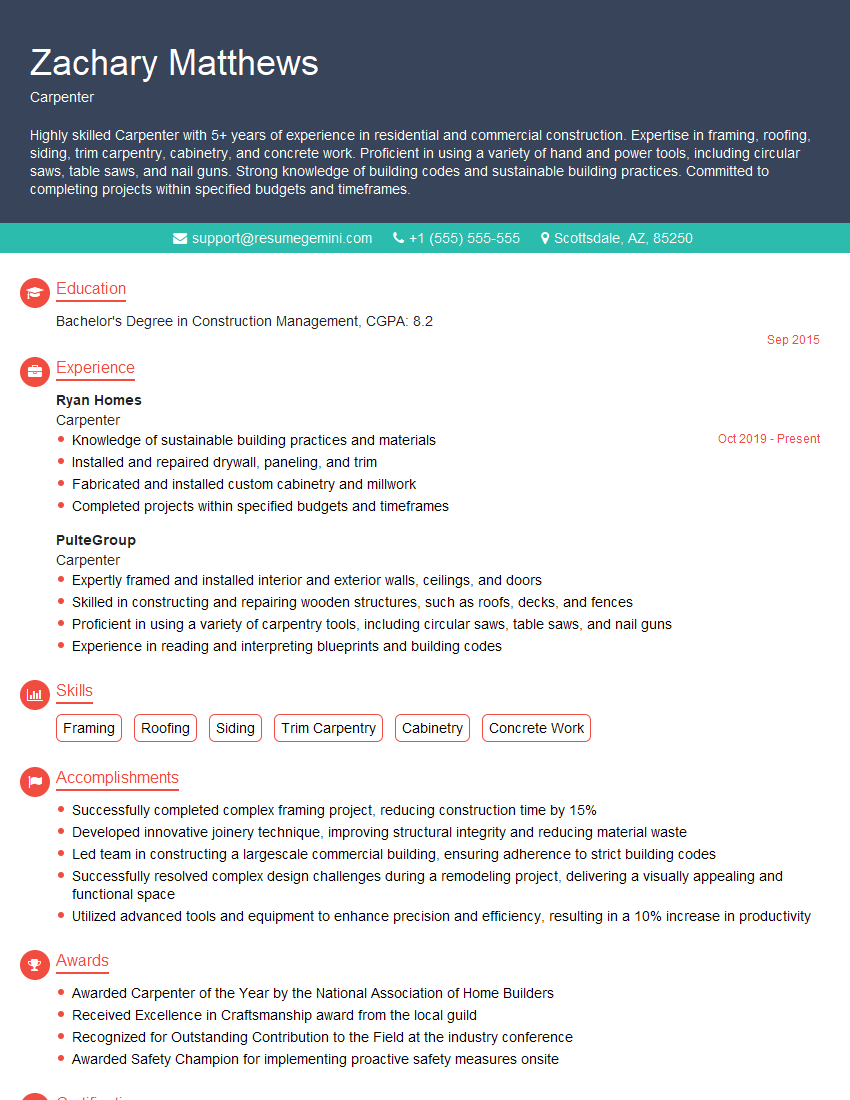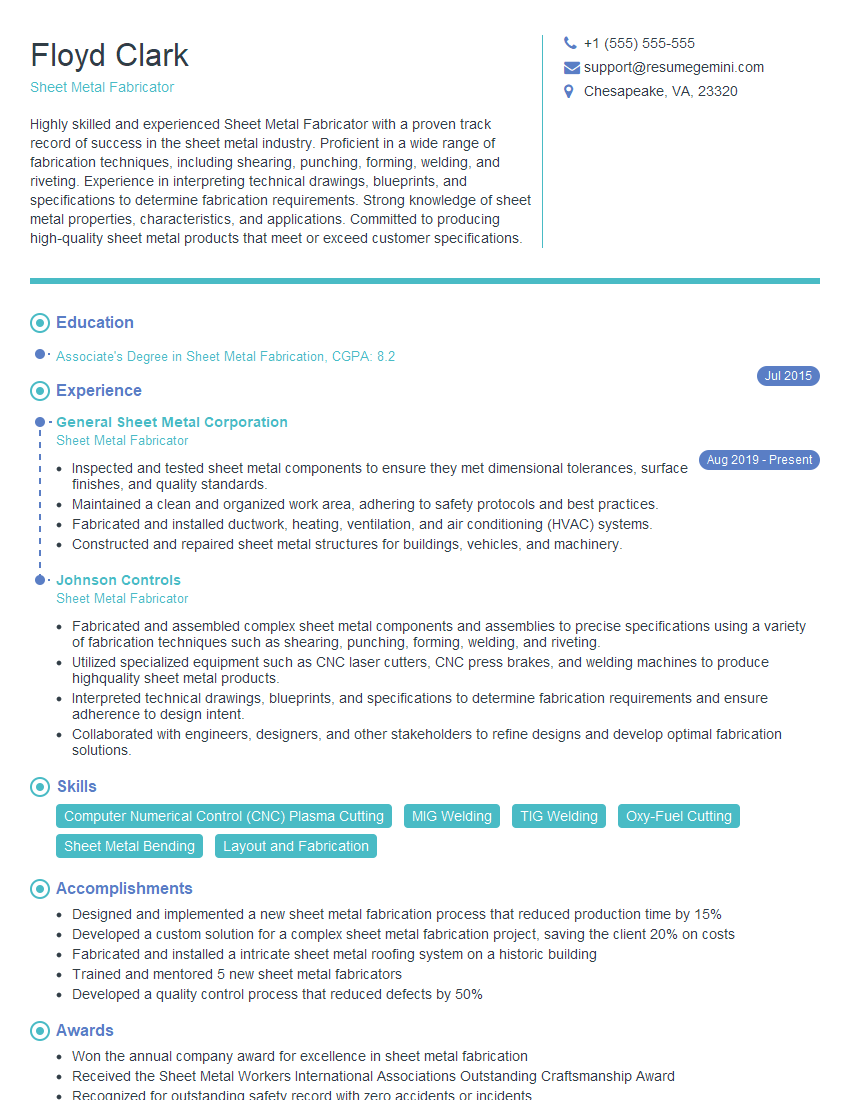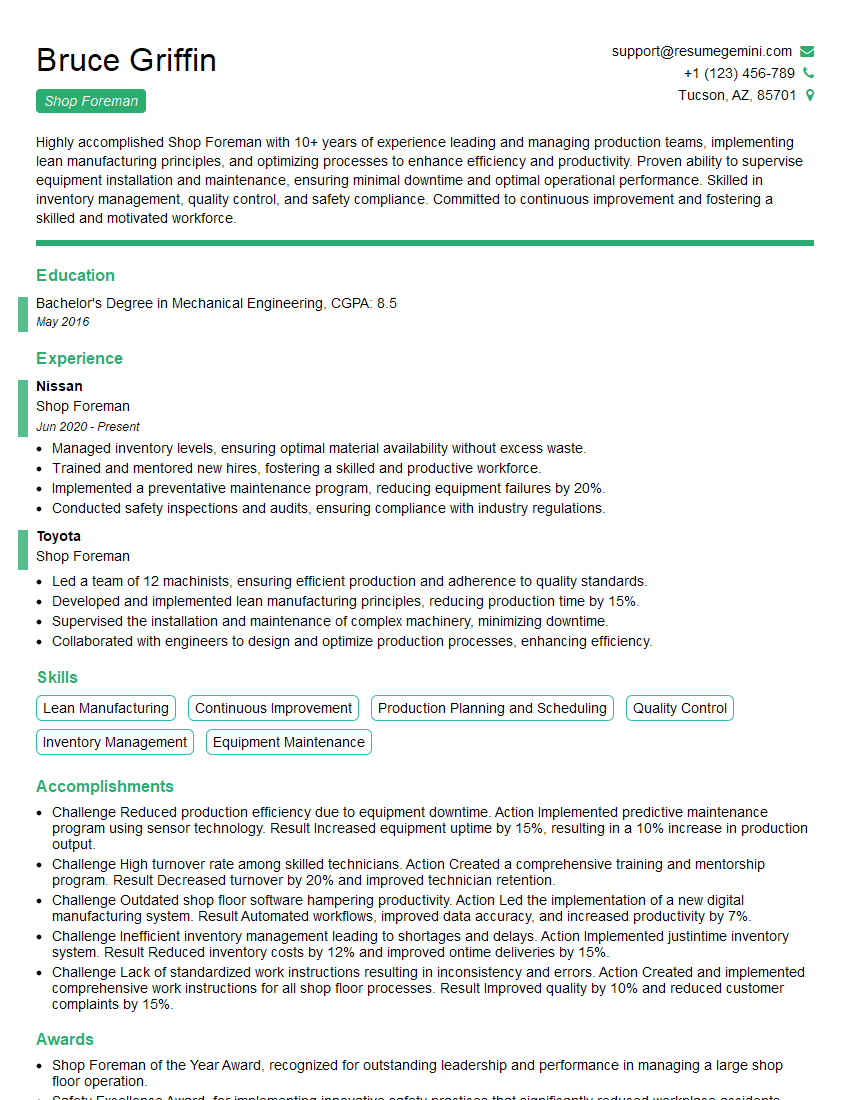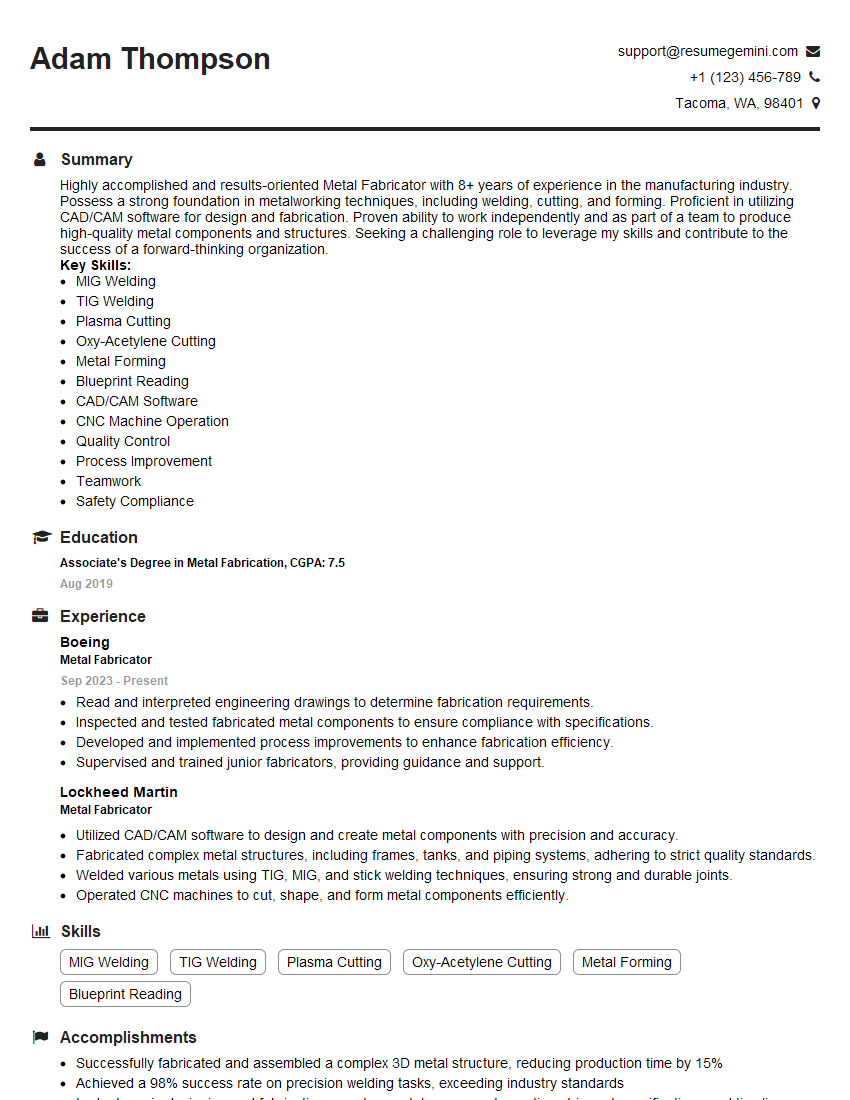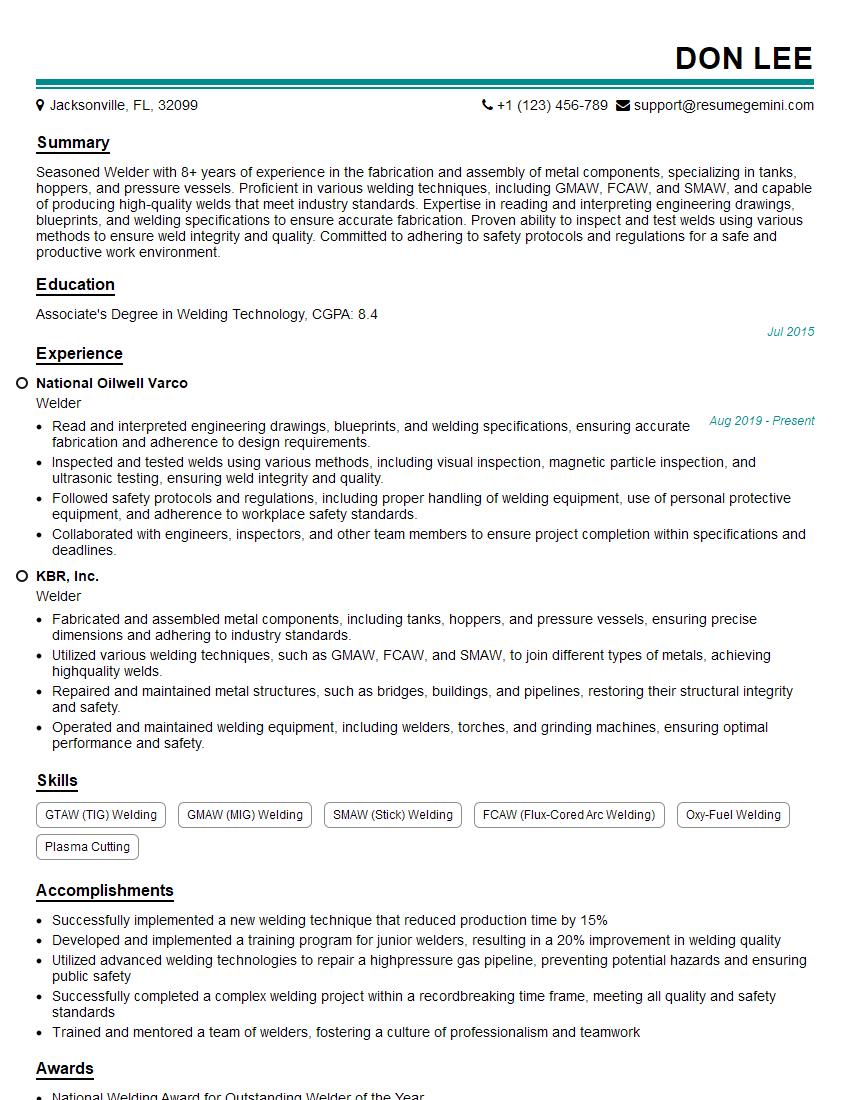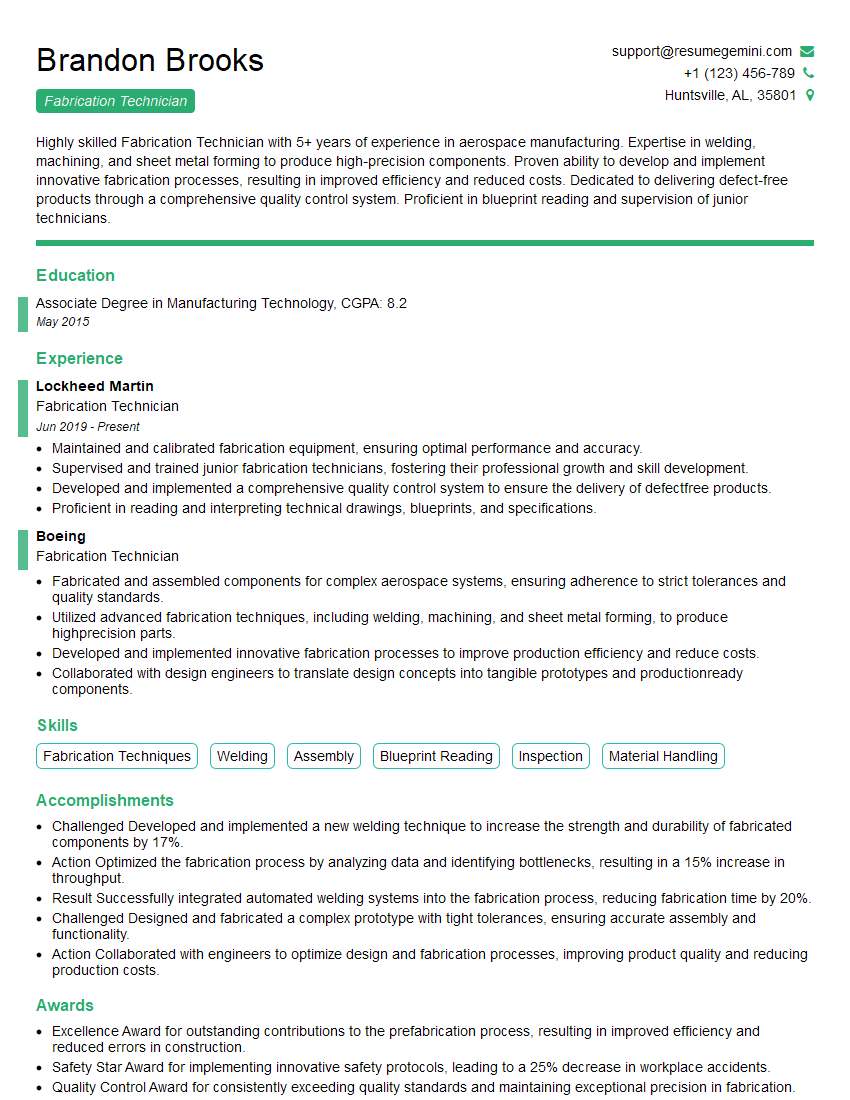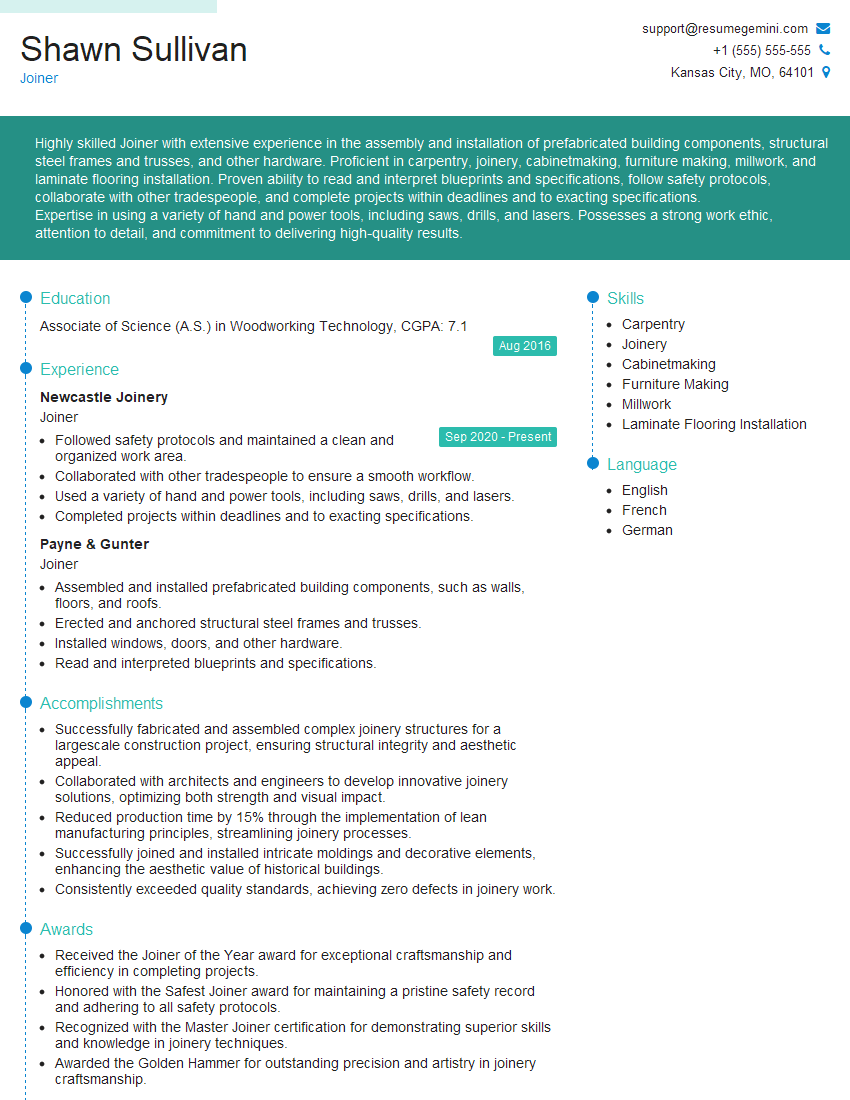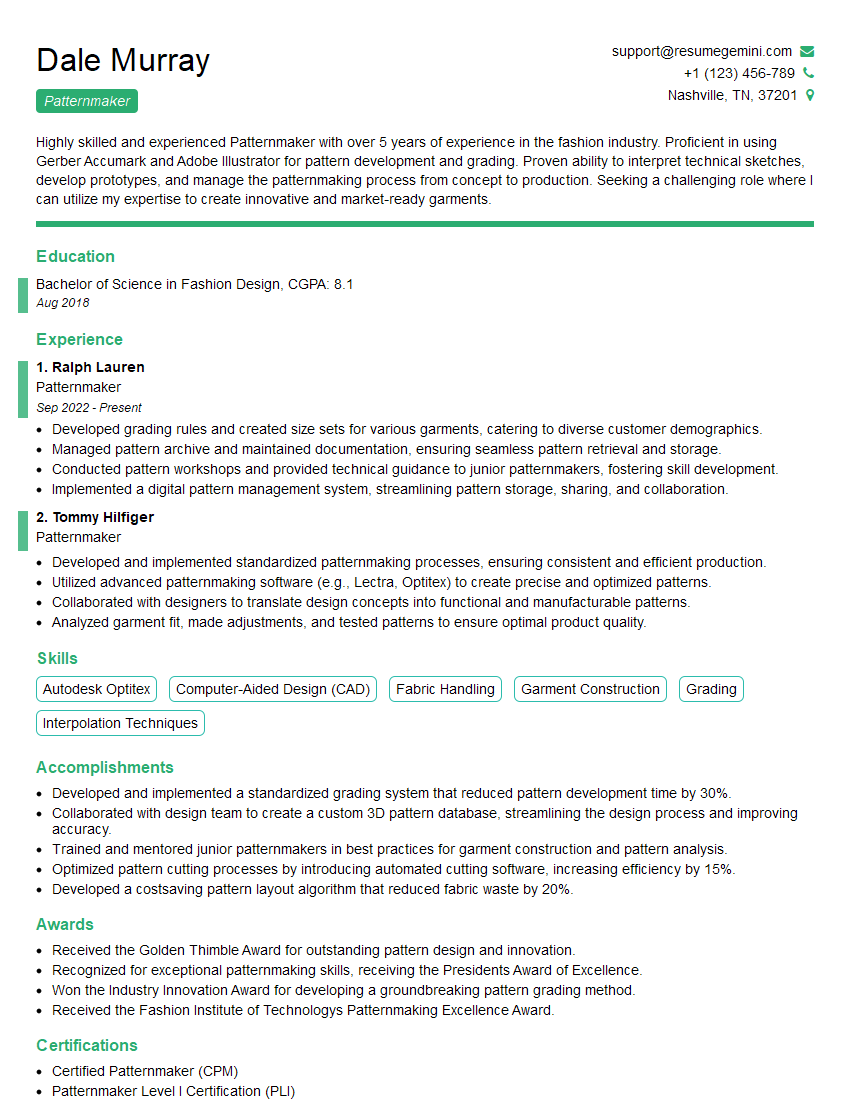Interviews are opportunities to demonstrate your expertise, and this guide is here to help you shine. Explore the essential Skilled in carpentry and fabrication techniques interview questions that employers frequently ask, paired with strategies for crafting responses that set you apart from the competition.
Questions Asked in Skilled in carpentry and fabrication techniques Interview
Q 1. What types of wood are best suited for outdoor applications?
Choosing the right wood for outdoor applications is crucial for longevity and durability. The best choices are those naturally resistant to rot, decay, and insect infestation. These resistances are often attributed to high density, natural oils, and resins within the wood.
- Cedar: Known for its beautiful reddish hue and natural resistance to decay. It’s often used for siding, fences, and decks.
- Redwood: Similar to cedar in its resistance properties, redwood is also prized for its strength and dimensional stability. It’s a popular choice for outdoor structures and landscaping.
- Cypress: Another excellent choice for outdoor use, cypress is durable and weather-resistant. It’s often used in boat building and exterior trim.
- Ipe: A very dense and durable hardwood from South America, Ipe is incredibly resistant to rot, insects, and weathering. It’s a premium option for decking and other high-stress outdoor applications but comes with a higher price tag.
- Pressure-treated lumber: While not a specific wood type, pressure-treated lumber is commonly used for outdoor projects. The treatment process injects preservatives into the wood, protecting it from rot and insects. However, it’s important to choose a treatment appropriate for ground contact if the application requires it.
When selecting wood for outdoor projects, always consider the specific climate and environmental conditions. For example, in areas with high humidity, choosing a wood with superior resistance to rot is paramount.
Q 2. Explain the different types of joints used in carpentry.
Carpentry joints are the crucial connections that hold wood pieces together. The choice of joint depends on the project’s requirements, including the type of wood, the load it will bear, and the aesthetic desired.
- Butt Joint: The simplest joint, where two pieces meet end-to-end. It’s often reinforced with glue, screws, or dowels for strength. Suitable for simple applications.
- Lap Joint: One piece overlaps another, creating a stronger connection than a butt joint. Variations include half-lap, where both pieces are cut halfway through, and miter lap, which uses angled cuts.
- Mortise and Tenon Joint: A very strong joint where a tenon (a projecting piece) fits into a mortise (a hole). This is a classic woodworking joint used in furniture and structural applications.
- Dovetail Joint: Known for its strength and aesthetic appeal, this joint uses interlocking ‘tails’ and ‘pins’ that resist pulling forces. Common in drawers and fine woodworking.
- Dado Joint: A groove cut into one piece to receive a second piece. Excellent for shelving and creating boxes.
- Miter Joint: Two pieces are joined at an angle, typically 45 degrees. Often used for picture frames and decorative trim. Requires careful cutting and often reinforcement for strength.
Many projects will utilize a combination of these joints to achieve optimal strength and stability. For example, a chair might use mortise and tenon joints for the legs and seat, while dado joints could be employed to create the chair’s back supports.
Q 3. Describe your experience with various woodworking tools.
My experience with woodworking tools is extensive, encompassing both hand tools and power tools. I’m proficient in using a wide range of equipment, including:
- Hand Tools: Chisels, hand saws (rip and crosscut), planes, marking gauges, squares, levels, clamps, mallets, and various types of files.
- Power Tools: Table saw, miter saw, jointer, planer, router, drill press, band saw, and various hand-held power tools such as drills, sanders, and jigsaw. I’m also experienced with operating CNC routers for more precise and intricate work.
I understand the nuances of each tool, including proper maintenance and safe operating procedures. For instance, I know the importance of using a push stick when ripping lumber on a table saw, and I always ensure that blades are sharp and properly aligned to prevent kickback and ensure clean cuts.
Beyond basic operation, I possess a deep understanding of tool selection based on material type and project requirements. The right tool dramatically affects both the efficiency and quality of the finished product.
Q 4. How do you ensure accuracy and precision in your work?
Accuracy and precision are paramount in carpentry. I employ a multi-pronged approach to ensure these qualities in my work.
- Precise Measurement: I always double-check measurements, using various tools like tape measures, squares, and calipers to ensure accuracy.
- Proper Tool Usage: Utilizing tools correctly and maintaining them in optimal condition significantly reduces errors. Sharp blades, properly aligned machinery, and careful technique are essential.
- Jig and Fixture Construction: For repetitive tasks or intricate cuts, I build jigs and fixtures to maintain consistency and precision. This is particularly crucial when working with complex designs or large-scale projects.
- Test Fitting: Before final assembly, I always test-fit components to identify and address any discrepancies early in the process. This preventative measure saves time and materials in the long run.
- Careful Planning: Thoroughly reviewing blueprints and planning the construction sequence helps to minimize mistakes. I always visualize the assembly process before commencing work.
An example of this would be creating a jig to cut identical mortise and tenon joints. This eliminates variation and ensures perfect alignment between the pieces.
Q 5. What safety precautions do you take when operating power tools?
Safety is my top priority when working with power tools. I religiously follow these precautions:
- Personal Protective Equipment (PPE): I always wear safety glasses or a face shield, hearing protection, and appropriate respiratory protection when necessary (e.g., when working with dust or chemicals). Depending on the project, I’ll also wear work gloves and a dust mask.
- Machine Guards: I ensure all machine guards are in place and functioning correctly before operating any power tools. This prevents accidental contact with moving parts.
- Proper Tool Usage: I only operate tools that I’m fully trained on, and I always follow the manufacturer’s instructions. This includes understanding the specific safety features and limitations of each tool.
- Workspace Organization: I maintain a clean and organized workspace, free of clutter. This minimizes tripping hazards and allows for safer movement around machinery.
- Emergency Procedures: I’m familiar with emergency procedures and have access to a well-stocked first aid kit and fire extinguisher.
Ignoring safety protocols can lead to serious injury. For example, failing to use a push stick when ripping wood on a table saw can result in kickback, which can cause severe injury. My commitment to safety ensures that I complete projects efficiently and without incident.
Q 6. Describe your experience with blueprint reading and interpretation.
I possess considerable experience in reading and interpreting blueprints. This involves understanding the different symbols, dimensions, and specifications represented in the drawings.
My process includes:
- Reviewing the overall plan: I start by examining the entire blueprint to understand the project scope, materials, and assembly sequence.
- Detailed analysis of individual components: I then carefully examine each component of the design, paying close attention to dimensions, angles, and material specifications.
- Identifying joints and connections: I meticulously analyze the indicated joints and connections to understand how the various pieces fit together.
- Understanding the scale: I accurately interpret the scale of the blueprint to translate the drawn dimensions into real-world measurements.
- Material selection: I carefully select the appropriate materials based on the blueprint’s specifications, ensuring that I choose materials that meet the required strength, durability and aesthetic qualities.
I have worked with a variety of blueprint styles, from hand-drawn sketches to sophisticated CAD drawings. My experience extends to adapting and interpreting drawings, which is essential when addressing unexpected site conditions or material availability issues.
Q 7. How do you handle unexpected challenges or problems on a project?
Unexpected challenges are inevitable in any construction project. My approach to handling them involves a systematic problem-solving process:
- Assessment: I begin by calmly assessing the situation, identifying the root cause of the problem and its potential impact on the project timeline and budget.
- Brainstorming: I brainstorm various solutions, considering their feasibility, cost-effectiveness, and impact on the overall project quality.
- Consultation: If necessary, I consult with other professionals, such as engineers or architects, to gain additional expertise and perspectives.
- Implementation: Once a viable solution is identified, I implement it carefully, documenting all changes made to the original plan.
- Evaluation: After implementing the solution, I carefully evaluate its effectiveness and make any necessary adjustments.
For instance, I once encountered unexpected rot in a structural beam during a renovation. Instead of panicking, I assessed the extent of the damage, consulted a structural engineer, and implemented a solution involving the replacement of the affected section with a reinforced beam. This approach ensured the structural integrity of the project without compromising quality or safety. My experience allows me to remain adaptable and creative in finding solutions to maintain project success.
Q 8. Explain your experience with different finishing techniques.
Finishing techniques are crucial for protecting and enhancing the appearance of wood and metal projects. My experience encompasses a wide range, from basic sanding and staining to more advanced methods.
Sanding: I’m proficient in using various grits of sandpaper to achieve different levels of smoothness, from rough shaping to a fine polish. This is fundamental for preparing surfaces for painting or staining.
Staining: I’ve worked with a variety of wood stains, understanding how different types (oil-based, water-based, etc.) affect the final color and finish. Proper preparation and application techniques are key to achieving even color and preventing blotchiness.
Painting: I’m skilled in applying both spray and brush techniques, ensuring even coverage and a professional finish. This includes choosing the right paint type (e.g., oil-based, latex) for the application and substrate.
Varnishing and Lacquering: These provide protection and enhance the natural beauty of wood. I understand the differences between various types of finishes and how to apply them to achieve a durable and aesthetically pleasing result. For example, polyurethane is excellent for high-traffic areas, while shellac offers a more traditional, amber-toned finish.
Powder Coating (for Metal): This provides a very durable and aesthetically pleasing finish for metal work. I understand the process including pre-treatment, powder application, and curing in an oven.
For instance, on a recent custom cabinet project, I used a combination of sanding, staining with a dark walnut stain, and applying three coats of polyurethane varnish to achieve a rich, durable finish that met the client’s specifications.
Q 9. What is your experience with different types of welding?
My welding experience covers several common types, each suited to different materials and applications.
Shielded Metal Arc Welding (SMAW or Stick Welding): This is a versatile method ideal for outdoor work and various metal types. I’m comfortable with different electrode types to achieve the appropriate weld properties.
Gas Metal Arc Welding (GMAW or MIG Welding): A highly efficient process for joining thinner materials, especially steel and aluminum. I’m experienced in choosing the correct shielding gas and wire feed speed to produce high-quality welds.
Gas Tungsten Arc Welding (GTAW or TIG Welding): This precise method creates clean, high-quality welds, perfect for intricate work and joining dissimilar metals. It requires greater skill and precision but results in aesthetically pleasing and strong welds. I’ve used this extensively for stainless steel and aluminum projects.
I can confidently select the appropriate welding process based on factors such as material thickness, joint design, and desired weld quality. For instance, I used TIG welding for a recent stainless steel sculpture, while MIG welding was sufficient for a steel framework project.
Q 10. Describe your experience with metal fabrication techniques.
Metal fabrication is a core skill, and I’m proficient in numerous techniques.
Cutting: I’m skilled in using various methods including plasma cutting, oxy-fuel cutting, and shearing, choosing the most suitable based on the material and project requirements. Accuracy is paramount, especially when working with intricate designs.
Forming and Bending: I’m experienced in using press brakes, rollers, and hand tools to shape sheet metal and other materials to precise specifications. This includes understanding the properties of different metals and how they react to bending forces.
Joining: Beyond welding, I’m proficient in various joining techniques including riveting, bolting, and brazing. The choice depends on the application and desired strength of the joint.
Finishing: I understand the importance of surface preparation and finishing techniques, including grinding, polishing, and powder coating, to achieve a high-quality and durable product.
A recent project involved fabricating a custom metal enclosure from sheet steel. This required accurate cutting using a plasma cutter, forming the panels using a press brake, welding the seams using MIG welding, and finally, applying a powder coating for corrosion protection.
Q 11. What safety measures do you employ while welding?
Safety is paramount in welding. My safety procedures are consistent and thorough.
Personal Protective Equipment (PPE): I always wear a welding helmet with appropriate shade lenses, welding gloves, flame-resistant clothing, and safety shoes. This protects against burns, sparks, and UV radiation.
Ventilation: Adequate ventilation is essential to remove harmful fumes produced during welding. I utilize ventilation systems or work outdoors when possible.
Fire Prevention: The workspace is kept clear of flammable materials, and a fire extinguisher is readily available.
Proper Technique: Maintaining a safe welding posture and using proper techniques prevents injuries and ensures quality welds.
Regular Equipment Inspection: I regularly inspect my welding equipment to ensure it’s in good working order and free from any defects that could compromise safety.
I regularly review safety protocols and attend safety training to stay up-to-date on best practices.
Q 12. How do you measure and cut materials accurately?
Accurate measurement and cutting are fundamental. My approach combines precision tools with careful technique.
Measurement Tools: I utilize a variety of tools depending on the project, including measuring tapes, rulers, calipers, and digital measuring devices. Double-checking measurements is a crucial step to avoid errors.
Layout Techniques: For complex cuts, I use precise layout techniques to mark the material accurately before cutting. This often involves using squares, marking gauges, and scribing tools.
Cutting Tools: The choice of cutting tool depends on the material and the required precision. For example, I use a miter saw for precise angle cuts in wood, a chop saw for accurate cuts in metal, and a bandsaw for intricate curves.
Jigs and Fixtures: For repetitive cuts or complex shapes, I often use jigs and fixtures to ensure consistency and accuracy.
For example, when building a frame, I always double-check my measurements and use a square to ensure the corners are perfectly 90 degrees. For curved cuts, I utilize a bandsaw with a jig to maintain uniformity.
Q 13. Explain your knowledge of different metal alloys and their properties.
Understanding metal alloys and their properties is vital for successful fabrication. Different alloys offer different strengths, weldability, and corrosion resistance.
Steel: Various grades of steel exist, from mild steel (easily weldable and machinable) to high-strength low-alloy steel (HSLAS) with increased strength and hardness. The choice depends on the application’s strength and ductility requirements.
Aluminum: A lightweight metal with excellent corrosion resistance. Different aluminum alloys have varying strengths and weldability. 6061 aluminum is commonly used for its weldability and strength, while 5052 is chosen for its corrosion resistance.
Stainless Steel: Known for corrosion resistance, different grades (e.g., 304, 316) offer varying levels of strength and weldability. 316 is commonly used in marine environments due to its superior corrosion resistance.
Brass and Bronze: These copper alloys offer excellent corrosion resistance and machinability, making them suitable for decorative and functional applications.
For instance, in choosing a material for a marine application, I’d select 316 stainless steel for its superior corrosion resistance compared to mild steel. For a lightweight component requiring high strength, 6061 aluminum would be a suitable choice.
Q 14. Describe your experience with CNC machining.
My experience with CNC machining is extensive. It allows for precise and repeatable fabrication of complex parts.
Programming: I’m proficient in using CAM software to generate CNC programs from CAD models. This involves selecting appropriate cutting tools, feeds and speeds, and ensuring toolpath optimization for efficient and accurate machining.
Machine Operation: I’m experienced in operating various CNC machines, including mills and lathes. This includes setting up the machine, loading and clamping workpieces, and monitoring the machining process.
Tool Selection: I understand the properties of various cutting tools and can select the most appropriate for the material being machined and the required surface finish. This includes knowing when to use end mills, drills, or turning tools.
Troubleshooting: I’m capable of troubleshooting common CNC machining problems, such as tool breakage, inaccurate cuts, or machine malfunctions. This includes knowing how to interpret error messages and make adjustments to the program or machine settings.
A recent project involved CNC machining aluminum parts for a robotic arm. The precision and repeatability of CNC machining were crucial for ensuring proper functionality of the robotic components.
Q 15. What is your experience with CAD/CAM software?
My experience with CAD/CAM software is extensive. I’m proficient in several industry-standard programs, including AutoCAD, SolidWorks, and Fusion 360. I use these tools throughout the design and fabrication process. For example, in a recent project building custom cabinetry, I used AutoCAD to create detailed 2D drawings of the individual components, ensuring precise dimensions and joinery details. Then, I utilized Fusion 360 to create a 3D model, allowing for virtual assembly and identification of potential interference issues before cutting any material. Finally, I generated CNC toolpaths from the 3D model in Fusion 360 to automate the cutting process on my CNC router, resulting in high accuracy and efficiency.
Beyond the design and cutting aspects, I utilize CAM software to simulate the machining process, optimizing cutting speeds and feeds to minimize material waste and maximize tool life. This integrated approach ensures accuracy, efficiency, and reduces errors in the final product.
Career Expert Tips:
- Ace those interviews! Prepare effectively by reviewing the Top 50 Most Common Interview Questions on ResumeGemini.
- Navigate your job search with confidence! Explore a wide range of Career Tips on ResumeGemini. Learn about common challenges and recommendations to overcome them.
- Craft the perfect resume! Master the Art of Resume Writing with ResumeGemini’s guide. Showcase your unique qualifications and achievements effectively.
- Don’t miss out on holiday savings! Build your dream resume with ResumeGemini’s ATS optimized templates.
Q 16. How do you maintain and care for your tools?
Maintaining my tools is paramount. It’s not just about extending their lifespan; it’s about safety and ensuring consistent, high-quality work. My routine involves cleaning each tool after every use, removing sawdust, resin, or other debris. I regularly lubricate moving parts with appropriate lubricants, preventing rust and ensuring smooth operation. I inspect for damage, sharpening blades and bits as needed. For example, I use a honing guide to keep my chisels razor sharp, which significantly improves the quality of my joinery. I store my tools in a well-organized manner, protecting them from damage and making them easily accessible. This prevents accidental damage and minimizes the risk of injury.
Furthermore, I keep a detailed inventory of my tools, noting their purchase dates and maintenance schedules. This allows for proactive maintenance and timely replacements, reducing downtime and ensuring I have the right tools for the job.
Q 17. Describe a time you had to troubleshoot a problem during a project.
During a recent project constructing a curved staircase, I encountered a significant challenge. The initial design, while aesthetically pleasing, presented difficulties in achieving smooth curves without noticeable seams in the curved handrail. The problem was that using standard bending techniques resulted in cracking in the wood. My troubleshooting process began by analyzing the design, carefully examining the stress points along the curve. I then researched alternative methods and materials. I eventually decided to laminate several thinner pieces of wood together using a flexible epoxy adhesive, allowing for a gradual curve that was both strong and visually seamless. This required precise measurements and careful application of the adhesive to prevent air pockets and ensure even distribution of the stress. The final result was a beautiful, structurally sound staircase that exceeded the client’s expectations.
Q 18. What is your experience with different types of adhesives and their applications?
My experience with adhesives is extensive, covering a wide range of materials and applications. I’m familiar with wood glues like polyurethane, aliphatic resin, and PVA (polyvinyl acetate), each suited for different purposes. Polyurethane, for example, is ideal for exterior applications due to its water resistance, while PVA offers excellent strength for interior joinery. For plastics, I use cyanoacrylate (super glue) for quick repairs or epoxy for stronger, more durable bonds, selecting the type based on the plastic’s properties. Working with composites requires careful selection, often utilizing specialized epoxy resins designed for specific composite materials. For metal work, I often utilize specialized metal adhesives or brazing techniques depending on the application and the metals involved. Choosing the right adhesive is crucial for the longevity and structural integrity of the final product; the wrong choice can lead to failure. For instance, using PVA glue outdoors on a project exposed to the elements would result in a weak, unreliable bond.
Q 19. How do you ensure the quality of your finished product?
Ensuring the quality of my finished product is a multifaceted process. It begins with careful planning and design, using precise measurements and detailed drawings. During construction, I meticulously follow the plans, maintaining attention to detail in every step. I use high-quality materials and tools. Regular quality checks throughout the process are essential, identifying and correcting any errors early. This includes checking for squareness, alignment, and proper fit of components. Once the project is complete, a final inspection is crucial, focusing on both aesthetics and functionality. I thoroughly check for any imperfections, ensuring that the product meets the required specifications and exceeds customer expectations. This rigorous approach results in high-quality, durable, and visually appealing products that are a testament to my craftsmanship.
Q 20. Describe your experience with working with different materials, such as plastics, composites and metals?
I have extensive experience working with various materials, including plastics, composites, and metals. My plastic fabrication experience includes working with acrylics, PVC, and ABS, utilizing techniques such as thermoforming, CNC routing, and adhesive bonding. I’ve worked with fiberglass-reinforced polymers (FRP) and carbon fiber composites, using techniques like vacuum bagging and autoclave curing. My metalworking experience encompasses ferrous and non-ferrous metals like steel, aluminum, and brass, utilizing processes like welding (MIG, TIG), cutting (plasma, laser), and machining. Each material demands a different approach, and my experience allows me to adapt my techniques appropriately. For example, welding steel requires a different technique and safety precautions compared to welding aluminum. Understanding the properties of each material is crucial for proper fabrication and ensures structural integrity and a quality outcome.
Q 21. What is your understanding of building codes and regulations?
I understand the importance of adhering to building codes and regulations. My familiarity extends to local, state, and national standards relevant to carpentry and fabrication. I understand the regulations concerning structural integrity, fire safety, and accessibility. Before starting any project, I review the relevant building codes and ensure that my designs and methods comply. This involves understanding load-bearing capacities, appropriate fastener specifications, and fire-resistant materials. For instance, I ensure proper spacing of joists and rafters to meet structural load requirements as outlined in the building codes. Non-compliance can lead to structural problems or even legal issues, jeopardizing the project and potentially causing harm. Staying informed about code changes is an ongoing process, and I regularly attend industry seminars and review updated code publications to stay current.
Q 22. How do you manage your time and prioritize tasks on a project?
Effective time management and task prioritization are crucial in carpentry and fabrication. I use a combination of methods, starting with a thorough review of project blueprints and specifications to understand the scope and dependencies between tasks. Then, I break down the project into smaller, manageable units, assigning each a realistic timeframe. I utilize tools like Gantt charts (sometimes a simple hand-drawn version suffices for smaller projects) to visualize the project timeline and identify potential bottlenecks. Prioritization is based on critical path analysis – identifying tasks that must be completed before others can begin. Urgent tasks with short deadlines are tackled first, while less time-sensitive tasks are scheduled accordingly. I regularly review my progress against the schedule, making adjustments as needed, and proactively communicate any delays or challenges to the team or client.
For example, on a recent custom cabinetry project, I prioritized the precise cutting and joinery of the main cabinet structures before moving on to the finishing details like drawer installation or door hardware. This ensured the structural integrity was addressed first, preventing costly mistakes later in the process.
Q 23. Describe your experience with project planning and management.
My experience in project planning and management spans several years and numerous projects, from small-scale residential renovations to larger commercial builds. I’m proficient in all stages, from initial consultation and design review to material sourcing, fabrication, and final installation. My approach involves close collaboration with clients and colleagues. I actively listen to their needs and incorporate their feedback into the project plan. I meticulously document every stage of the project, including material lists, process notes, and progress photos, which is vital for troubleshooting and future reference. I also maintain a clear communication channel to keep everyone informed of progress, potential problems, and any necessary adjustments.
For instance, on a recent deck construction project, I created a detailed plan that included material quantities, a step-by-step construction sequence, and a projected timeline. This allowed me to effectively manage resources, order materials in advance, and stay on schedule, leading to a successful and timely completion.
Q 24. What are your strengths and weaknesses as a carpenter/fabricator?
My strengths lie in my precision and attention to detail. I take pride in creating high-quality, durable pieces that meet or exceed client expectations. I’m adept at working with a variety of materials and possess a strong understanding of different joinery techniques, including mortise and tenon, dovetail, and biscuit joints. I’m also a quick learner, readily adapting to new challenges and technologies. My problem-solving skills are excellent; I can quickly identify and resolve issues, often finding creative solutions to complex problems.
A weakness I’m actively working on is delegation. While I enjoy the hands-on aspect of my work, I’m learning to more effectively delegate tasks to others when appropriate, to improve efficiency and team collaboration on larger projects.
Q 25. How do you stay updated on new technologies and techniques in carpentry and fabrication?
Staying current in carpentry and fabrication requires continuous learning. I subscribe to industry magazines and online publications like Fine Woodworking and Popular Woodworking. I actively participate in online forums and communities dedicated to woodworking and fabrication, engaging in discussions and learning from experienced professionals. I also attend workshops and seminars whenever possible, to stay abreast of the latest techniques and technologies, such as CNC machining or advanced joinery methods. I experiment with new tools and materials in my own projects, applying my knowledge in practical ways. For example, recently I completed an online course on using parametric design software for creating complex three-dimensional models for bespoke furniture.
Q 26. Describe your experience with working in a team environment.
I thrive in team environments. I believe collaboration is key to successful project completion. I’m a strong communicator and actively listen to my teammates’ input and perspectives. I am comfortable sharing my knowledge and expertise, mentoring junior members of the team when necessary. I am also adept at coordinating tasks, ensuring that everyone understands their role and responsibilities. I believe in a respectful and supportive work environment, where open communication and mutual respect are paramount. I’ve worked on numerous team projects where open communication and clear roles were crucial to meeting deadlines and producing high-quality work.
For example, on a recent restaurant renovation, I collaborated effectively with electricians and plumbers to ensure seamless integration of our respective work, avoiding potential conflicts and delays.
Q 27. What are your salary expectations?
My salary expectations are commensurate with my experience and skills, and are in line with the industry standards for experienced carpenters and fabricators in this region. I’m open to discussing a competitive compensation package that reflects the scope and demands of the position.
Q 28. Do you have any questions for me?
Yes, I do have a few questions. I’d like to learn more about the specific projects this role will involve and the opportunities for professional development within the company. I’m also interested in understanding the company culture and the team I would be working with.
Key Topics to Learn for Skilled in Carpentry and Fabrication Techniques Interview
- Woodworking Fundamentals: Understanding various wood types, their properties, and appropriate joinery techniques (e.g., mortise and tenon, dovetail, dado).
- Tool Knowledge and Safety: Demonstrating proficiency with hand tools (saws, chisels, planes) and power tools (routers, table saws, planers), emphasizing safe operating procedures and maintenance.
- Fabrication Processes: Familiarity with metal fabrication techniques such as welding (MIG, TIG, stick), cutting (plasma, oxy-fuel), and bending, including material selection and safety precautions.
- Blueprint Reading and Design Interpretation: Ability to accurately interpret technical drawings, sketches, and specifications to translate designs into finished products.
- Measurement and Precision: Highlighting skills in accurate measuring, cutting, and fitting to achieve precise dimensions and tolerances.
- Project Management and Time Estimation: Demonstrating experience in planning, executing, and completing projects within budget and schedule constraints.
- Problem-Solving and Troubleshooting: Showcasing ability to identify and resolve issues during the construction or fabrication process, using creative solutions and adapting to unexpected challenges.
- Quality Control and Inspection: Explaining methods for ensuring high-quality workmanship and adhering to industry standards.
- Finishing Techniques: Knowledge of various finishing methods for wood and metal, including sanding, staining, painting, and polishing.
- Health and Safety Regulations: Understanding and complying with relevant workplace safety regulations and best practices.
Next Steps
Mastering carpentry and fabrication techniques opens doors to diverse and rewarding career opportunities, offering growth potential in construction, manufacturing, and specialized trades. To significantly increase your chances of landing your dream job, create an ATS-friendly resume that highlights your skills and experience effectively. ResumeGemini is a trusted resource that can help you build a professional and impactful resume, ensuring your qualifications stand out to potential employers. Examples of resumes tailored to carpentry and fabrication techniques are available to help guide you in crafting your own compelling application materials.
Explore more articles
Users Rating of Our Blogs
Share Your Experience
We value your feedback! Please rate our content and share your thoughts (optional).
What Readers Say About Our Blog
Live Rent Free!
https://bit.ly/LiveRentFREE
Interesting Article, I liked the depth of knowledge you’ve shared.
Helpful, thanks for sharing.
Hi, I represent a social media marketing agency and liked your blog
Hi, I represent an SEO company that specialises in getting you AI citations and higher rankings on Google. I’d like to offer you a 100% free SEO audit for your website. Would you be interested?
